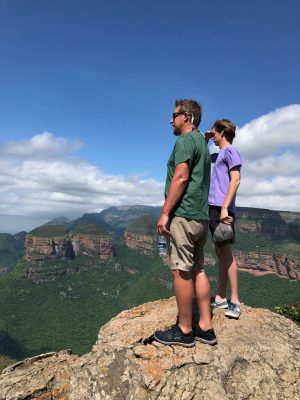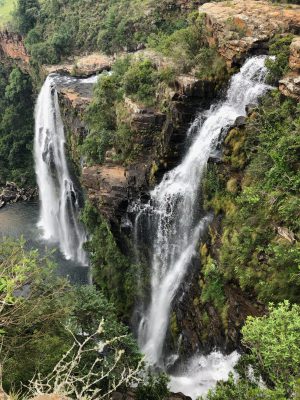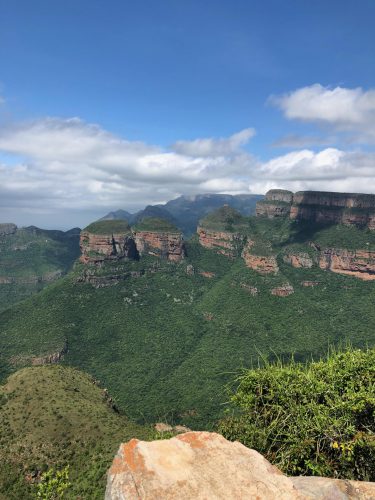Extending along the lip of the great African escarpment the Blyde River Canyon is the third-largest canyon in the world (after the Grand Canyon and the Fish River Canyon in Namibia). Since 1965, over 1100 square miles of the canyon and its surroundings have been protected as part of the Blyde River Canyon Nature Reserve.
Roughly 200 million years ago, when the ancient supercontinent, Gondwanaland, broke apart, the Drakensberg escarpment was formed, and Madagascar and Antarctica tore free from Africa. The broken edge of the continent gradually tilted upwards under the weight of a vast shallow sea stretching west, laying down layers of dolomite and sandstone sediments. Continued geological movement and erosion created the towering cliffs that make the canyon so impressive today.
supercontinent, Gondwanaland, broke apart, the Drakensberg escarpment was formed, and Madagascar and Antarctica tore free from Africa. The broken edge of the continent gradually tilted upwards under the weight of a vast shallow sea stretching west, laying down layers of dolomite and sandstone sediments. Continued geological movement and erosion created the towering cliffs that make the canyon so impressive today.
At the confluence of the Blyde (Happy) River and the Treur (Sorrow) River, the swirling waters have carved out a series of tubular wells and plunge pools known as the Bourke’s Luck Potholes. A bit of a misnomer, perhaps, since prospector Tom Bourke never actually found any gold in or around them, as he believed he would.
Also the world’s largest green canyon, it is a prime destination for birders. While the vulnerable blue swallow, the elusive Pel’s fishing owl and the endangered Cape Vulture all soar here, it is most famously known for being South Africa’s only breeding site of the rare Taita Falcon.
At 6,400 feet, the canyon’s highest peak is named for a renowned  Bapedi Chief, Mabjaneng Maripi Mashile while the well-known Three Rondavels, three circular grass-topped peaks resembling the traditional houses of the native people, are named after his three legendary troublesome wives: Mogabolie, Mogaladikwe and Maserotho.
Bapedi Chief, Mabjaneng Maripi Mashile while the well-known Three Rondavels, three circular grass-topped peaks resembling the traditional houses of the native people, are named after his three legendary troublesome wives: Mogabolie, Mogaladikwe and Maserotho.
From the cliffs of God’s Window, named for God’s imagined view over the Garden of Eden, one sees across the Lowveld, over Kruger National Park to the distant Lebombo Mountains and the Mozambican border.
The Pinnacle Rock is a massive 99-ft freestanding quartzite rock towering over the dense indigenous forest of Driekop Gorge.
The Panorama Scenic Route follows the canyon from one spectacular feature to the next, including a selection of beautiful waterfalls – the Sabie Falls, Bridal Veil Falls, Mac Mac Falls. The Kadishi Tufa Waterfall is the second-highest Tufa waterfall in the world and also called the “weeping face of nature” because, at the right angle, it resembles a giant stone face crying into the clear pools below. (A Tufa waterfall is created when calcium-rich water builds the rock face over which it is flowing as the calcium and mud hardens into interesting shapes.)
Clients who have taken some extra time to explore the Panorama Route, either by design or due to the logistics of traveling to Kruger from Victoria Falls or Botswana, have often found it to be a perfect compliment to the safari experience. We’d be delighted to discuss what the addition of this stunningly scenic region might look like in your itinerary.
